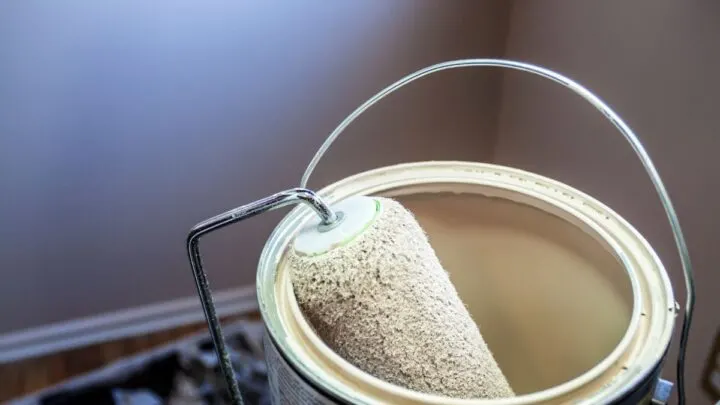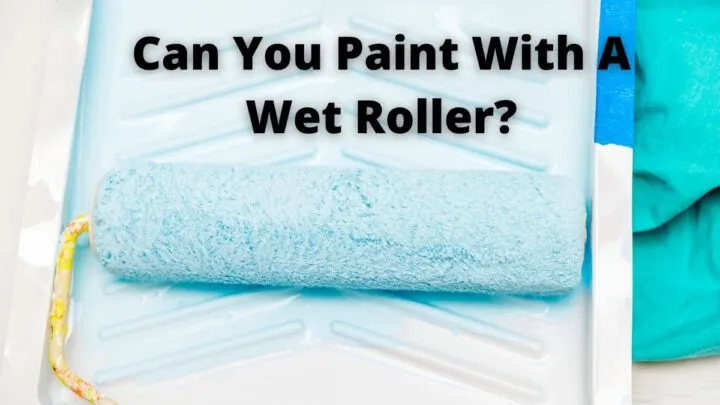Wet rollers have become increasingly popular in recent years, as they offer a number of advantages over dry rollers. But can you paint with a wet roller?
For many beginner painters, the idea of using a wet roller can be daunting.
After all, paint is notoriously difficult to work with, and adding water to the mix seems like it would only make things worse.
You can easily paint with a wet roller. This method is actually the preferred way to use a paint roller, as it allows for more even coverage and fewer streaks.
When painting with a wet roller, you will want to use water-based paint since it is easier to work with and will dry more quickly.
Paint rollers can be a great way to quickly and evenly paint a surface, but there are a few things you need to know before you start using them.
In this article, we will discuss the basics of using a wet roller, including what type of paint to use, how to apply it, and how to clean up afterward.
We’ll also cover some common mistakes people make when painting with a wet roller and provide tips for avoiding them.
So, whether you’re a beginner or an experienced painter, read on for everything you need to know about painting with a wet roller.
Can You Paint with a Wet Roller?
The short answer to this question is yes. You can paint with a wet roller.
A wet roller is simply a paint applicator that has been dampened with water before use.
This allows the paint to glide smoothly and evenly over the surface of whatever you are painting.
When painting with a wet roller, it is important to be as economical as possible with your paint application so that you don’t end up wastefully dripping or splattering excess paint on your project.
To achieve even coverage using a wet roller, it is best to start work in small areas and progress systematically until the entire project is complete.
Though widely used by professional painters, a wet roller can also be an ideal choice for DIY projects or touch-ups around the home.
So whether you’re tackling a big painting project or just trying to spruce up an old piece of furniture, remember that you can certainly paint with a wet roller.

Is A Roller Better Than a Brush?
Let’s discuss some of the advantages and disadvantages of using this type of applicator.
In general, rollers are faster and easier to use than brushes, making them a great choice for large projects.
They also tend to produce fewer brush strokes than brushes, giving your finished project a more even appearance.
On the other hand, rollers can be tricky to maneuver in tight spaces or around obstacles.
And because they hold more paint than brushes, it is easy to accidentally apply too much paint if you’re not careful.
Rollers can be difficult to clean if you don’t have the right supplies on hand.
But don’t worry – we’ll discuss how to clean your roller (and brushes) later on in this article.
What Type of Paint Should You Use With A Roller?
When selecting a paint for use with a roller, there are two main things to keep in mind: the type of surface you’ll be painting and the finish you’re hoping to achieve.
For most surfaces, an acrylic latex paint is a good choice. This type of paint is easy to work with and dries quickly, making it ideal for painting projects large and small.
However, if you’re planning on painting a surface that will be exposed to moisture, such as a bathroom or kitchen, you’ll need to use a paint that is specifically designed for these types of surfaces.
These “moisture-resistant” paints are typically either oil-based or water-based alkyd paints.
As for the finish, most people opt for either semi-gloss or high-gloss when painting with a roller.
These finishes are easy to clean and resist stains well, making them ideal for areas that see a lot of traffic or moisture.
If you’re not sure which finish to choose, ask your local paint store associate for advice.

How Do You Apply Paint with A Wet Roller?
Now that we’ve gone over some of the basics let’s discuss how to actually apply paint with a wet roller.
Before getting started, be sure to lay down drop cloths or old newspapers to protect the area around your project.
Once you’ve done this, open your can of paint and pour some into a paint tray.
Then, dip your roller into the paint and roll it back and forth until it is evenly coated.
Next, begin painting in small sections, using even strokes and working from top to bottom.
Be sure to “feather” the edges of each section as you go so that you don’t end up with any visible lines or streaks. To do this, simply brush outward from the edge of each section with your roller.
As you work, periodically check your paint tray to make sure that your roller is still evenly coated. If it starts to look dry, dip it back into the paint and continue painting as usual.
How Do You Clean a Wet Roller?
Cleaning a wet roller is pretty simple – all you need is some water and a little elbow grease.
To start, remove as much excess paint from your roller as possible by rolling it onto a piece of cardboard or paper towel.
Then, run the roller under warm water until the paint loosens. Once it does, continue rinsing the roller until all of the paint has been removed.
Finally, use your hands to massage any remaining paint out of the roller before setting it out to dry.
If you’re using water-based paint, you can also put your roller in the washing machine on a gentle cycle.
Just make sure to let it air dry completely before using it again. You’ll need to use a paint thinner or solvent to remove the paint from your roller for oil-based paints.
Simply soak the roller in the solvent for a few minutes, then rinse it under warm water until all of the paint has been removed.
Summing Up Painting With a Wet Roller
Using a wet roller may seem odd, but it’s actually considered a more effective way to paint than using a dry roller. Dampening the roller before painting allows a more even coverage.
Make sure you read this guide before starting your DIY wet roller project. After you start painting, you’ll have a great looking room all thanks to using the wet roller technique!


